Notre Dame averaged ten yards per play and held New Mexico to a 9.5% passing success rate in an explosive home opener. Yet there were some lingering red flags that will need to be cleaned up to have a shot at an upset in Athens. Breaking down the blowout of the Lobos and highlighting some reasons for encouragement and concern through two games.
Something not clear? Check out this handy advanced stats glossary.
Garbage time by SP+ definition began at the start of the 3rd Quarter with the Irish ahead by 31. However, for tracking purposes I’ll count all plays where the Notre Dame first team offense and defense continued playing, the 7:19 mark of the 3rd quarter when the Irish went ahead 52-7. As a result 32.6% of plays took place in garbage time and are not included in the stats below.
Explosiveness
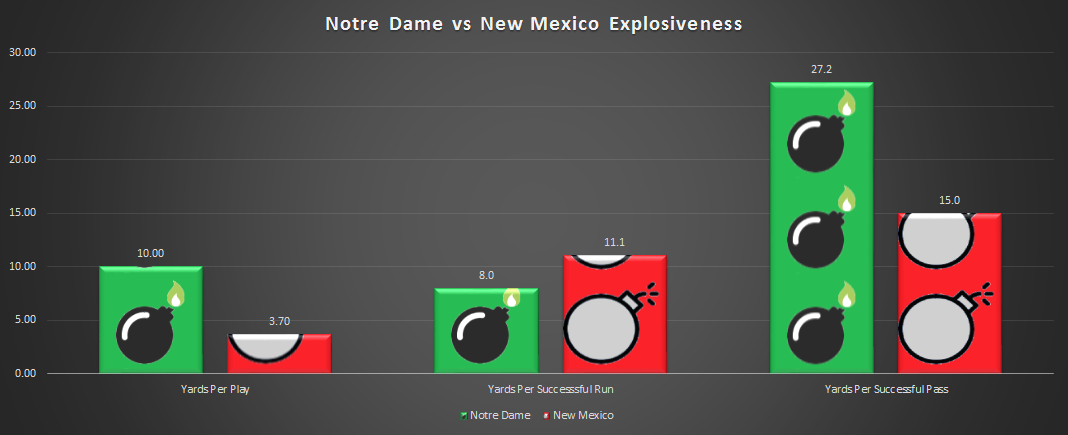
The Irish offense put up a ridiculous 10 yards per play before garbage time, a high-mark of the Brian Kelly era and since I’ve begun tracking these numbers in 2015. To say things started slowly would be an understatement – the ND offense had 45 total yards on 16 plays (2.81 YPP) in the first quarter. But Chip Long seemed to open the offense up a bit in the second quarter, and once the floodgates opened, the Lobos defense, as predicted, could do little to stem the tide.
The pop-pass touchdowns to Avery Davis and Chris Finke swing the numbers in a big way – you could certainly argue these really function and should be counted as run plays. Counting them as passes, as the official box score and advanced stats systems will, passes averaged 14.1 yards per play and runs 4.28. Ian Book wasn’t perfect but certainly bounced back in terms of comfort in the pocket and decision making, with some terrific throws in the second and third quarter. The early 3rd down conversion to Lawrence Keys as he moved to his left was vintage 2018 Book – using his mobility to set up a difficult, medium-range downfield throw that was on the money. The deep balls to Claypool and Javon McKinley were similarly encouraging as a necessary ingredient for the offense’s success moving forward.
The running game, at least in a conventional sense, swings back into worrisome territory after a strong start at Louisville. In a game where the offensive line should dominate, carries by running backs before the second string came in averaged just 1.88 yards per carry. This is a small sample size of just nine carries, but relying on Book as a runner and pop passes and jet sweeps isn’t ideal as the degree of difficulty increases dramatically over the next few weeks.
| Leverage Rate | Average 1st Down Gain | Average 3rd Down Distance | 3rd Down Conversion % | |
| Notre Dame | 79.1% | 11.76 | 7.14 | 14.3% |
| New Mexico | 60.0% | 5.40 | 7.38 | 23.1% |
Defensively, there was a similar chasm in success defending the run and pass. The New Mexico passing game was clearly hurting in a bad way, but you still have to give Clark Lea’s defense credit for dominating, allowing just 1.81 yards per pass attempt despite no sacks. Once the Notre Dame defense forced them into passing downs, it was virtually hopeless for the Lobos and again to ND’s credit they turned these situations not just into stops but also turnovers. It’s hard to complain much when you have three interceptions and three 3-and-outs in ten possessions before garbage time!
But because we are Irish fans, complain we will. The Irish defense yielded 5.07 yards per run attempt against an offense that could really only pray that their rushing attack worked and was running on over 70% of 1st and 2nd downs. On first down runs, when Notre Dame should have been expecting it all the way, New Mexico ran for an even six yards per carry and was successful on 57% (8 of 14) of those attempts.
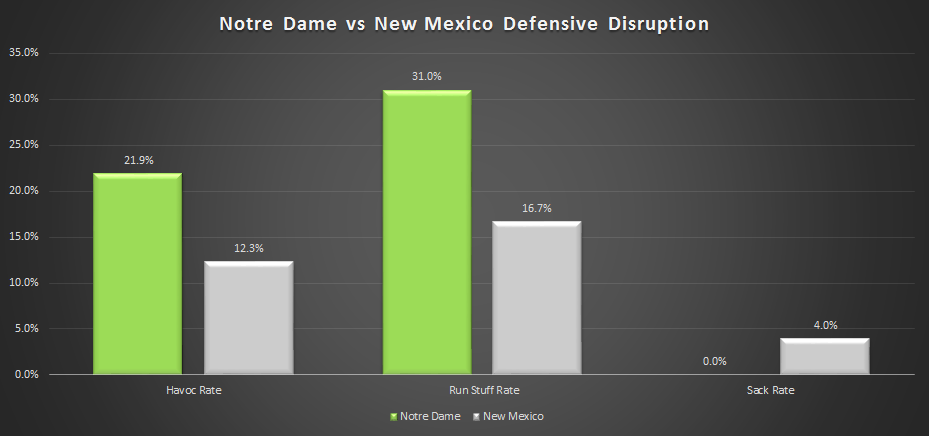
The Irish were able to survive bending a lot in the run game through thanks to a second straight week of strong disruption and ability to generate negative plays. A 31% stuff rate is better than Clemson’s mutant defensive line last year, and those negative plays often threw New Mexico into passing downs they had virtually no chance of converting. More details later in the Georgia preview, but in a small sample it’s notable that the run defense has been far more “boom or bust” than in 2018. Is that a reflection of a couple opponents, the turnover and new personnel in the middle of the defense, or a shift in scheme?
Efficiency
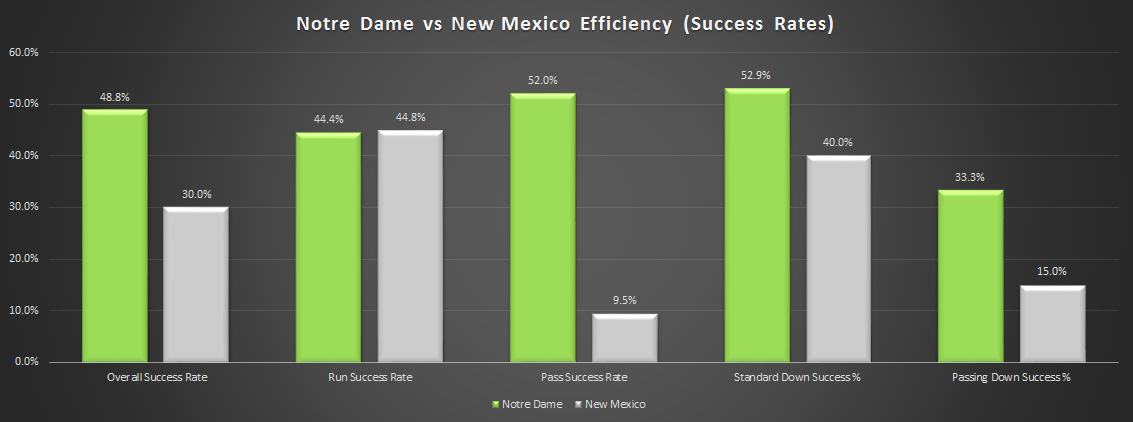
With the running games equally efficient, a night and day difference in passing success gave the Irish a strong overall advantage. At this point I think Irish fans may take for granted Ian Book’s efficiency in the pass game – while he certainly can improve his in-game consistency, and slow starts could be costly against better opponents, Notre Dame has had above average success rate through the air in every Book start except the Cotton Bowl against Clemson.
In his 11 regular season starts, the Book-led passing attack has been at a 40% success rate in every game and over 50% in six. In contrast, Brandon Wimbush hit 50% just once, at Michigan State in 2017. The vaunted 2015 offense hit over 50% pass efficiency five times in 13 games (one by Malik Zaire against Texas, four by DeShone Kizer against UMass, Navy, Pitt, and Stanford).
The run game allowing a 44% success rate (current national average in 2019 is 42%) isn’t encouraging, but has been offset by excellence on passing downs. A huge portion of this can be explained by the matchups – Louisville and New Mexico ranked 112th and 115th in Passing SP+ last season and don’t appear to have made the leap to “respectable” in that category. But the combination of pass rush ability (effective despite a lack of sacks on the box score) and talent in the secondary should continue to be lethal, especially with Shaun Crawford looking spry as ever and Kyle Hamilton seamlessly stepping into playmaking status as a true freshman.
Finishing Drives, Field Position, & Turnovers
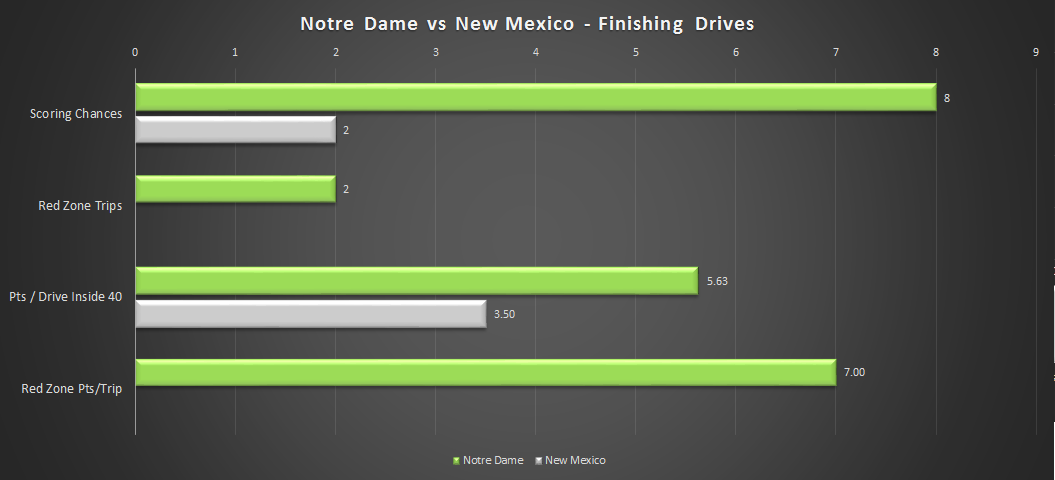
The Irish dominated creating scoring chances and converting them, moving inside the Lobos 40 on 8 of 11 drives before garbage time. Notre Dame started slowly – the first of these chances was derailed by an early sack and ended with a punt – but then converted touchdowns in this area as well as explosive plays from outside it (these count as finishing score drives too in SP+). The only other non-touchdown in the final seven scoring opportunities was the Doerer field goal before the half where time was the limiting factor, not the Irish offense.
Notre Dame won the turnover battle 4-0, extending their early turnover margin to a ridiculous +6 for the season and 1st in FBS at +3 per game. They’ve been on the whole slightly lucky, recovering 5 of 8 potential fumbles when you’d expect 50%, but they’ve also only put the ball on the ground twice. The interception of pass break-up ratio is a also a bit higher than expected thanks to New Mexico throwing several passes right to Irish defenders, but let’s not penalize the Lobos for their generosity. Ian Book continues to keep the ball out of trouble, with just one New Mexico pass break up in the game.
The Irish capitalized off these turnovers, a solid Jay Bramblett home debut, and the general ability to move the ball more successfully to create a significant field position advantage. The average ND drive started at their own 32 as opposed to New Mexico beginning each drive nine yards further from the end zone.
On to Athens
A few themes digging into the numbers so far that will be key to an Irish upset against a top-3 opponent this weekend:
Can Notre Dame make Jake Fromm beat them?
In 2018 and 2019, over 17 starts, Fromm has thrown the ball over 25 times in just three of those games. Those three games? At LSU, the SEC Championship, and bowl game against Texas – all losses. Now, there’s definitely some correlation is not causation there, because in the vast majority of games Georgia can run the ball so effectively and establish big early leads and have little need to throw. But while the offense may have slightly changed with James Coley taking over at OC for Jim Chaney, the Dawgs preferred formula still revolves around running the ball. In each of those losses Fromm was also under 8 yards per attempt; on the less optimistic side, the junior also has 9 games in that time span with over 10 YPA, a mark Ian Book has hit just three times, including last week.
It’s a better matchup overall for the Irish defense for the run game if they can force those passing situations – it enables Lea to put four of his best pass rushers on the field at the same time, potentially go to the dime package that’s worked so well early in the year, and Georgia’s wide receivers, while super talented, are also very young and could be limited in their route trees and brings more potential for miscommunication.
Can Irish execute bend but don’t break against the run?
Getting into those passing down situations against UGA will not be easy, because it requires slowing down the Dawgs ground game that’s arguably the best in the country. Through two games, the Notre Dame run defense has also been shockingly “boom or bust”. Experimentation with different rotations at linebacker could explain some of this, but the run defense has been more disruptive but also more likely to give up a longer run. The chart below breaks down the % of runs stopped for no gain or a loss, gains of 1-4 yards, 5-9 yard, and 10+ compared to a season ago:
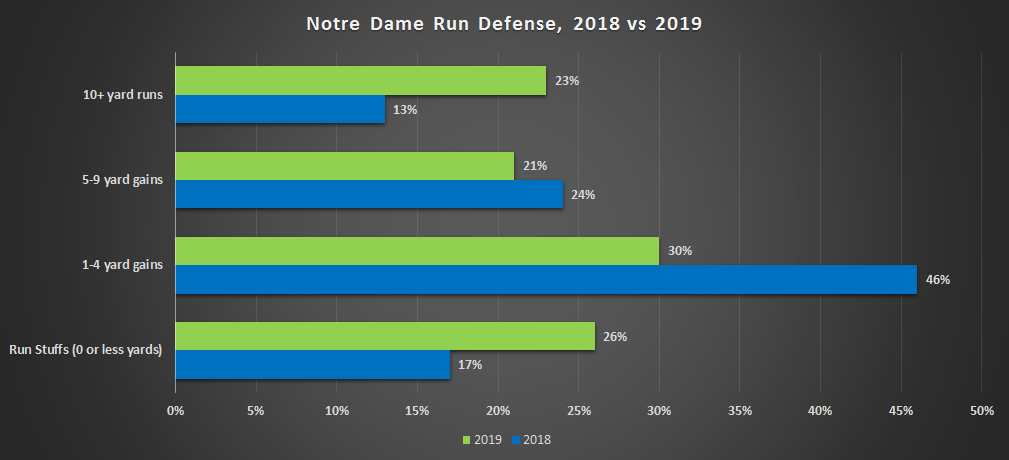
Against Georgia this could be deadly, as Deandre Swift, James Cook, and the stable of Bulldog blue-chip backs can turn what were 10 and 12 yard gains versus Louisville and New Mexico into house calls. It feels inevitable that with this offensive line the Dawgs will be able to move the ball, but if the Irish defense can force them to string long drives together without penalties or a couple negative plays or incompletions derailing them they stand a better chance than if getting gashed for explosive plays.
The one relative weakness of the UGA offense last year was red zone performance – from Bill Connelly’s numbers last season:
- In open play (snaps between the offense’s 10 and the defense’s 30), Georgia’s success rate is 54.1 percent, third in FBS.
- Between the opponent’s 21 and 30, Georgia’s success rate is 48.8 percent, 19th.
- Between the opponent’s 11 and 20, Georgia’s success rate is 46 percent, 26th.
- Inside the opponent’s 10, Georgia’s success rate is 40 percent, 116th.
- Inside the opponent’s 3, Georgia’s success rate is 28.6 percent, 129th.
The Irish will need to keep scoring opportunities close to have a chance, but even if they create a few less opportunities they may be able to hang in this game if they can hold Georgia to field goal attempts and convert touchdowns in their chances. In 2017 that killed the Irish, who actually had more scoring opportunities than UGA but converted just one touchdown in six drives that went inside the Georgia 40 and settled for four field goals. This season Notre Dame has scored touchdowns on seven of eight red zone visits (87.5%, tied for 4th in FBS) and in 2017/2018 the Irish were consistently top-25 for much of both seasons converting scoring opportunities into points.
Can Notre Dame turn things around on third down, especially third and short?
After a 1 of 10 performance on third downs against New Mexico, the Irish overall rank 121st in 3rd down conversion percentage (27%). As Eric pointed out in his review, this overstates the issues a bit since Notre Dame was in garbage time for a few and converted all five 4th down attempts in the game.
The power run game is a striking issue – Notre Dame is now just 3 of 9 converting on opportunities of 3rd/4th and two yards to go or fewer. Last year the Irish converted 78% of those runs, 23rd best in FBS! Some of this feels like Chip Long playing possum- ND has actually run the ball on every 3rd/4th and two or less, a scenario where in 2018 they threw the ball 38% of the time. And interestingly enough, the offense was hyper-effective with Book throwing in those short yardage situations, converted 12 of 15 pass attempts for first downs!
On the other side of the ball, the Irish have also struggled in power run defense, allowing opponents to convert all five of their run attempts so far on 3rd and 4th or less. It’s a small sample, and an average team converts around 65-70% of these attempts, so not worth panicking over yet. But it will likely take getting a couple stops in these critical opportunities to slow the UGA offense.



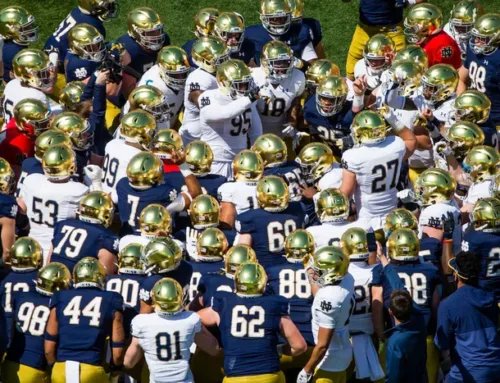
Love these articles!
So, I guess we’re probably going to see Georgia RTDB for most of the game
This game makes me very nervous. I am fully in “hoping it isn’t a blowout” mode. I would be pretty happy with a 7-10 pt loss right now.
One of you more seasoned amateur writers could probably help me with this, but I’m guessing we haven’t tried stacking the box in either of the games this year to stop the run. My thought process being given the strength of our corners and safeties, would we not be able to get 7/8 guys in the box to stop the run and still be able to hold up relatively well against the passing game? Maybe even put Gilman in a Tranquill like role where he is functioning like a linebacker and racking up tackles. I realize Georgia would probably torch us deep a couple times, but might be better than a slow 6 yard a carry death.
The tricky thing there is that UGA has run more out of spread formations, giving a veteran QB like Fromm flexibility if you choose to bring safeties down or play closer to the line. I agree in general that I’d scheme to stop run first and make UGA pass to win one on one, but their counter will be to put 3 receivers and sometimes a motioned RB or a TE out wide and challenge our players to tackle in space there, an area I worry about a bit as Pride is a bit of a downgrade from Love there IMO, Crawford/Bracy aren’t the biggest, etc.
Thanks for putting this up. I look forward to these advanced stats articles every week. (well, I don’t always look forward to them, but I know they’ll always be informative). Unfortunately, in this case, it looks like the advanced stats are telling us the same things our eyeballs are telling us – defense against the run is really bad, and offense has shown explosiveness but not much efficiency on the run. I hope we’ve been holding things back for Georgia and come out looking like a different team.
Here’s I think the best reasons for optimism for the defense:
1. The defense could be better off with a QB that isn’t a running threat, simplifying things a bit for green LBs who may be thinking a bit more than ideal about role/responsibilities on each plays and options
2. Tightening up rotations could help too. Even with the early struggles at Louisville I think there was intent to find out who the staff could trust, best groupings, etc. I think there’s also potentially things both defensively and offensively the staff has kept close to the vest (more Gilman in a Rover-like role, for example, with Hamilton in at safety).
3. In the Elko/Lea era, we’ve defended the run in big games / against better rushing opponents pretty well. Etienne broke the long back-breaking run in the Cotton Bowl but Clemson was held to average run efficiency and I thought we defended the run well. We obviously dominated UM in the opener, who had a top -40 run offense, and when UGA visited in ’17 (granted, 1st Fromm start) we held the run game well in check. Stanford was a top-10 run attack with Bryce Love in ’17 and Costello really was the one who beat us, they ran for only 4 yards per rush.
Well the advanced running stats might make me feel a little better. Sure, we stink against the run, but it appears if we can keep UGA from housing us from the 40 or so and make them play in the RZ, we might have a good chance to play FG.